 Facebook
Facebook
 X
X
 Instagram
Instagram
 TikTok
TikTok
 Youtube
Youtube
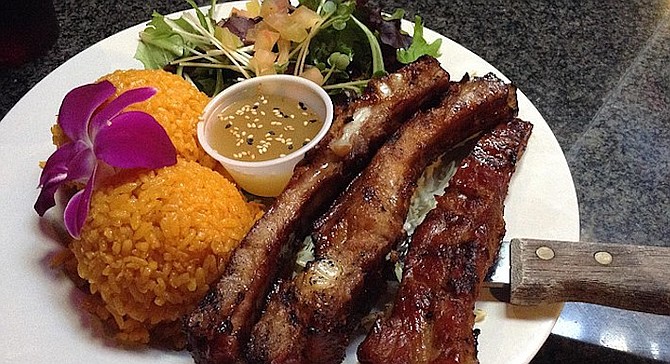
Canvas sign blurs by.
“Matua’s… Islander Grill.”
Wha? There’s no eateries in this part of the Barrio. What’s up?
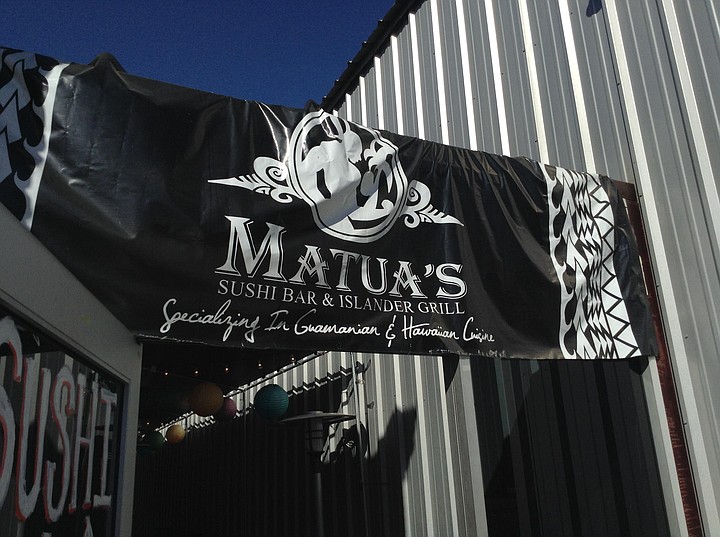
I pull the cord on the 901. Sixteenth and National. Whole city of homeless tents stretches north. Then, where a passage leads to Sushi on a Roll, a kind of wholesale sushi factory, I see the new banner.
“Matua’s Sushi Bar & Islander Grill.”
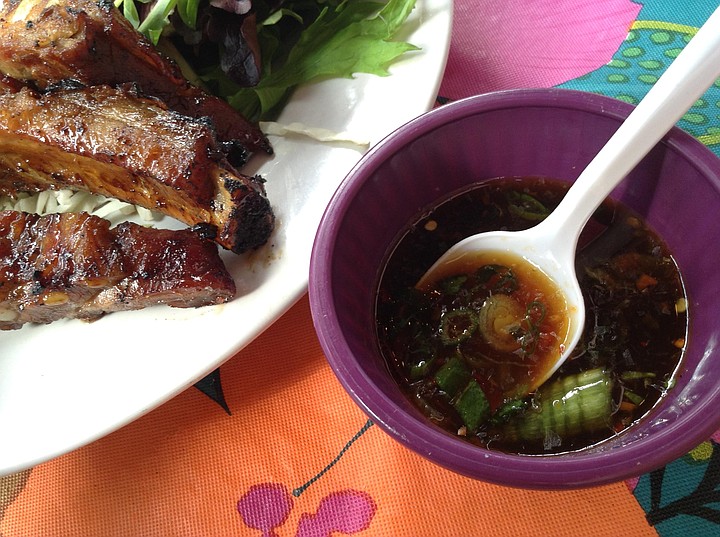
Must be down this same passage.
Tables line it. “Yes, we’re pretty new,” says this gal at the end. “We used to be down in Chula Vista.”

It takes your eyes a while to dial down from the glare of the sun outside, but when they do, right here near Father Joe’s, you’re in this classy semi-underground room with skylights, way-big murals of koi fish, giant white and red sake vats that look like ceremonial drums, a circular bar of dark marble, and the torporific sounds of laid-back reggae songs on the system.
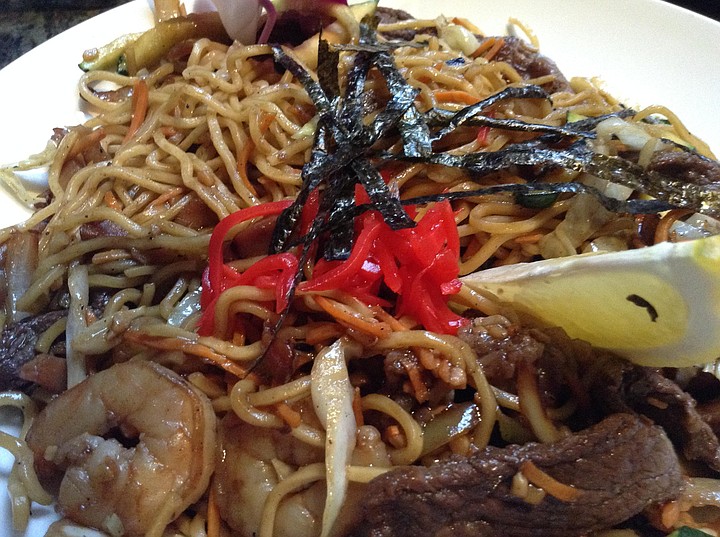
I take a seat at the bar and watch as four big plates of food parade by, on their way to a group of guys and gals further around the circle.
“Wow. What are those?” I ask the manager gal, Isabel.
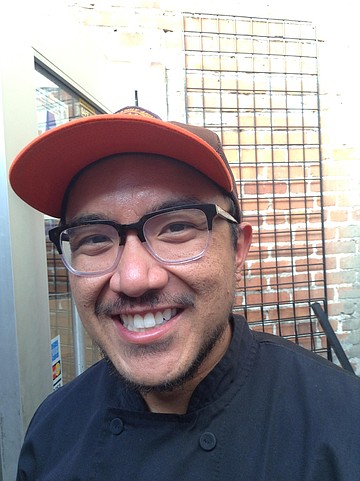
“Well, first one’s the Hawaiian Combo, with the huli huli chicken and the kalua pig with cabbage, macaroni cheese, and rice.”
“So, mainly Hawaiian food here?”
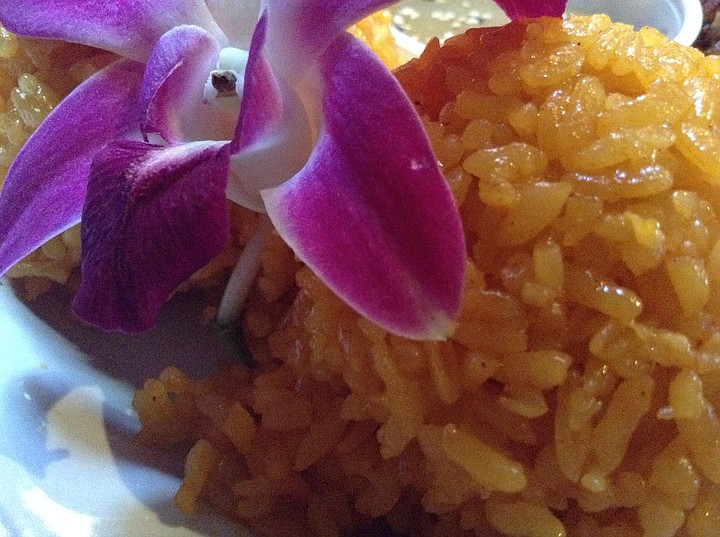
“Not really. Racquel, she’s the owner, along with her dad, they’re Chamorro, so Chamorro food, too.”
“Chamorro?”
Need a quick geography lesson here. Turns out “Chamorro” is the name for the people who live on Guam, the U.S. territory that’s basically the summit of a chain of mountains that haul up from the deepest spot on Earth, the Marianas Trench, 36,000 feet down. So that’s like living on top of Mt. Everest plus 7000 more feet.
And, oh yeah....I remember now. Coming up 500 years ago, in 1520, Magellan’s first round-the-world fleet got totally left behind and out-sailed by these Chamorran ocean-going outriggers.
Guam’s south of Japan, east of the Philippines, west of Hawaii. So, foodwise, you can expect Chamorran — Guamanian — food to be a mix. But here, so far, seems like the Japanese is the strongest gastro-tide running.
Like, these dishes passing by are chicken katsudon (fried, panko’d chicken, $9.95); yakisoba (stir-fried noodles with chicken, beef, and shrimp, $14.95); salt-and-pepper chicken wings ($10); and that Hawaiian combo, with huli huli chicken, kalua pig, cabbage, macaroni salad, and rice ($17.95).
“So, which is the most Chamorran dish?” I ask Ronnel, the chef who’s checking for orders.
He points to chicken kelaguen. “That’s very Chamorran.”
It’s chopped BBQ chicken in a pickling marinade of lemon juice, grated coconut, green onion, and crushed red peppers. Actually, they do a lot kelaguen-style. The beef kelaguen is thin slices of raw sirloin that you “cook” in the acids of fresh lemon juice, along with green onions, soy, and crushed red pepper. Costs $14.95. Or shrimp ($15.95).
Yes, I’m looking for cheaper. Notice that under “Pupus,” starters, they have “Spam Musubi,” meaning Spam wrapped in rice and seaweed, for $5. Same with teriyaki chicken musubi. Empanadas, “traditional Chamorro-style masa harinashells filled with Grandma Rosie’s spicy chicken purée,” They go four for $8.
I’m interested in Grandma Rosie, but actually, it’s Uncle Frank’s pork ribs that have my eye. “Pork ribs marinated Chamorro style and cooked on a closed charcoal grill, $12.95.”
I go for that and, man, I’m so glad I did. The first thing you notice is the orchid. Purple, planted into startling orange rice. Behind that, a little bowl of sesame ponzu sauce, a house salad of sprouts, arugula, and marinated cucumber chunks.
But the main attraction is the pork ribs, three of them glistening and steaming away, wafting up charcoal smells and saying, “Eat me!”
Then, behind them, another little bowl of liquids, with peppers and spices gleaming out.
“Finadene sauce,” says Ray. “It’s a must, back in Guam.”
Finadene’s a combo of lemon, soy, green onions, and a mix of habanero and serrano peppers plus crushed red pepper. So, okay, spiced-up soy, and you breathe a little fire, but I tell you, it turns these ribs from “great” to “Ay! Caramba!” Dang, they’re delicious.
“Munghi!”
“Wha?”
“That’s how you say ‘delicious!’ in Chamorro.” says Ronnel. “‘I na minannge.’ ‘It’s so tasty.’”
And with the sharp but beautiful taste of the finadene, the rice is an important palliative here: plus, it glows up at you as orange as a Chamorro sunrise. Turns out the coloring comes from seeds of the achiote tree, a.k.a. the “lipstick tree.” “We use the seeds of the achiote for coloring but also for the flavoring, the peppery effect,” says Ronnel.
He says the Spanish brought achiote over from Central America. “We were under a lot of Spanish influence,” says Ray Rodriguez. “They were in charge for, like, 300 years. So I guess Guamanians today like their food more sour and spicy than, say, Filipinos or Hawaiians.”
There’s a couple more Chamorro eateries in San Diego. Not surprising: more than 25,000 Chamorros have settled in here. Many, like Ray’s dad, are ex-Navy. Heck, that’s a seventh of the entire population back in Guam.
Of course, this ain’t happy hour. They have one 3–6, Monday–Friday. Then you’re getting pu-pus (starters) at around $4, $5.
Oh, and “matua”?
“It means ‘the leaders, the lordly ones, the upper echelon of Chamorro society,’” says Ray.
Am I coming back? Oh, yes. For more Uncle Frank. That stuff is munghi.
The Place: Matua’s Sushi Bar & Islander Grill, 1620 National Avenue, Barrio Logan, 619-693-5800
Hours: 11 a.m.–9 p.m. daily (Saturday, Sunday, till 10 p.m.)
Prices: Spam Musubi, (Spam in rice, seaweed), $5; teriyaki chicken musubi, $5; empanadas with spicy chicken purée, four for $8; chicken katsudon (fried, panko’d chicken), $9.95; yakisoba (stir-fried noodles, chicken, beef, shrimp), $14.95; salt-and-pepper chicken wings, $10; Hawaiian Combo (huli huli chicken, kalua pig, macaroni salad, rice), $17.95; chicken kelaguen (chopped BBQ chicken in lemon juice marinade), $11.95; beef kelaguen, $14.95; shrimp kelaguen, $15.95; Uncle Frank’s pork ribs, achiote rice, house salad, $12.95
Buses: 901, 929
Nearest bus stops: National at 16th
Trolley: All lines
Nearest trolley stop: 12th & Imperial Transit Center


Canvas sign blurs by.
“Matua’s… Islander Grill.”
Wha? There’s no eateries in this part of the Barrio. What’s up?

I pull the cord on the 901. Sixteenth and National. Whole city of homeless tents stretches north. Then, where a passage leads to Sushi on a Roll, a kind of wholesale sushi factory, I see the new banner.
“Matua’s Sushi Bar & Islander Grill.”

Must be down this same passage.
Tables line it. “Yes, we’re pretty new,” says this gal at the end. “We used to be down in Chula Vista.”

It takes your eyes a while to dial down from the glare of the sun outside, but when they do, right here near Father Joe’s, you’re in this classy semi-underground room with skylights, way-big murals of koi fish, giant white and red sake vats that look like ceremonial drums, a circular bar of dark marble, and the torporific sounds of laid-back reggae songs on the system.

I take a seat at the bar and watch as four big plates of food parade by, on their way to a group of guys and gals further around the circle.
“Wow. What are those?” I ask the manager gal, Isabel.

“Well, first one’s the Hawaiian Combo, with the huli huli chicken and the kalua pig with cabbage, macaroni cheese, and rice.”
“So, mainly Hawaiian food here?”

“Not really. Racquel, she’s the owner, along with her dad, they’re Chamorro, so Chamorro food, too.”
“Chamorro?”
Need a quick geography lesson here. Turns out “Chamorro” is the name for the people who live on Guam, the U.S. territory that’s basically the summit of a chain of mountains that haul up from the deepest spot on Earth, the Marianas Trench, 36,000 feet down. So that’s like living on top of Mt. Everest plus 7000 more feet.
And, oh yeah....I remember now. Coming up 500 years ago, in 1520, Magellan’s first round-the-world fleet got totally left behind and out-sailed by these Chamorran ocean-going outriggers.
Guam’s south of Japan, east of the Philippines, west of Hawaii. So, foodwise, you can expect Chamorran — Guamanian — food to be a mix. But here, so far, seems like the Japanese is the strongest gastro-tide running.
Like, these dishes passing by are chicken katsudon (fried, panko’d chicken, $9.95); yakisoba (stir-fried noodles with chicken, beef, and shrimp, $14.95); salt-and-pepper chicken wings ($10); and that Hawaiian combo, with huli huli chicken, kalua pig, cabbage, macaroni salad, and rice ($17.95).
“So, which is the most Chamorran dish?” I ask Ronnel, the chef who’s checking for orders.
He points to chicken kelaguen. “That’s very Chamorran.”
It’s chopped BBQ chicken in a pickling marinade of lemon juice, grated coconut, green onion, and crushed red peppers. Actually, they do a lot kelaguen-style. The beef kelaguen is thin slices of raw sirloin that you “cook” in the acids of fresh lemon juice, along with green onions, soy, and crushed red pepper. Costs $14.95. Or shrimp ($15.95).
Yes, I’m looking for cheaper. Notice that under “Pupus,” starters, they have “Spam Musubi,” meaning Spam wrapped in rice and seaweed, for $5. Same with teriyaki chicken musubi. Empanadas, “traditional Chamorro-style masa harinashells filled with Grandma Rosie’s spicy chicken purée,” They go four for $8.
I’m interested in Grandma Rosie, but actually, it’s Uncle Frank’s pork ribs that have my eye. “Pork ribs marinated Chamorro style and cooked on a closed charcoal grill, $12.95.”
I go for that and, man, I’m so glad I did. The first thing you notice is the orchid. Purple, planted into startling orange rice. Behind that, a little bowl of sesame ponzu sauce, a house salad of sprouts, arugula, and marinated cucumber chunks.
But the main attraction is the pork ribs, three of them glistening and steaming away, wafting up charcoal smells and saying, “Eat me!”
Then, behind them, another little bowl of liquids, with peppers and spices gleaming out.
“Finadene sauce,” says Ray. “It’s a must, back in Guam.”
Finadene’s a combo of lemon, soy, green onions, and a mix of habanero and serrano peppers plus crushed red pepper. So, okay, spiced-up soy, and you breathe a little fire, but I tell you, it turns these ribs from “great” to “Ay! Caramba!” Dang, they’re delicious.
“Munghi!”
“Wha?”
“That’s how you say ‘delicious!’ in Chamorro.” says Ronnel. “‘I na minannge.’ ‘It’s so tasty.’”
And with the sharp but beautiful taste of the finadene, the rice is an important palliative here: plus, it glows up at you as orange as a Chamorro sunrise. Turns out the coloring comes from seeds of the achiote tree, a.k.a. the “lipstick tree.” “We use the seeds of the achiote for coloring but also for the flavoring, the peppery effect,” says Ronnel.
He says the Spanish brought achiote over from Central America. “We were under a lot of Spanish influence,” says Ray Rodriguez. “They were in charge for, like, 300 years. So I guess Guamanians today like their food more sour and spicy than, say, Filipinos or Hawaiians.”
There’s a couple more Chamorro eateries in San Diego. Not surprising: more than 25,000 Chamorros have settled in here. Many, like Ray’s dad, are ex-Navy. Heck, that’s a seventh of the entire population back in Guam.
Of course, this ain’t happy hour. They have one 3–6, Monday–Friday. Then you’re getting pu-pus (starters) at around $4, $5.
Oh, and “matua”?
“It means ‘the leaders, the lordly ones, the upper echelon of Chamorro society,’” says Ray.
Am I coming back? Oh, yes. For more Uncle Frank. That stuff is munghi.
The Place: Matua’s Sushi Bar & Islander Grill, 1620 National Avenue, Barrio Logan, 619-693-5800
Hours: 11 a.m.–9 p.m. daily (Saturday, Sunday, till 10 p.m.)
Prices: Spam Musubi, (Spam in rice, seaweed), $5; teriyaki chicken musubi, $5; empanadas with spicy chicken purée, four for $8; chicken katsudon (fried, panko’d chicken), $9.95; yakisoba (stir-fried noodles, chicken, beef, shrimp), $14.95; salt-and-pepper chicken wings, $10; Hawaiian Combo (huli huli chicken, kalua pig, macaroni salad, rice), $17.95; chicken kelaguen (chopped BBQ chicken in lemon juice marinade), $11.95; beef kelaguen, $14.95; shrimp kelaguen, $15.95; Uncle Frank’s pork ribs, achiote rice, house salad, $12.95
Buses: 901, 929
Nearest bus stops: National at 16th
Trolley: All lines
Nearest trolley stop: 12th & Imperial Transit Center
Comments